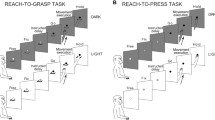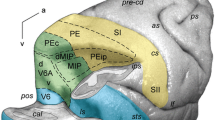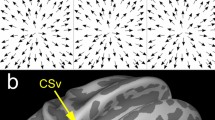Abstract
Very little is known about the role of the cingulate motor area (CMA) in visually guided reaching compared to other cortical motor areas. To investigate the hierarchical role of the caudal CMA (CMAc) during reaching we recorded the activity of neurons in CMAc in comparison to the supplementary motor area proper (SMA) while a monkey performed an instructed delay task that required it to position a cursor over visual targets on a computer screen using two-dimensional (2D) joystick movements. The direction of the monkey’s arm movement was dissociated from the direction of the visual target by periodically reversing the relationship between the direction of movement of the joystick and that of the cursor. Neurons that responded maximally with a particular limb movement direction regardless of target location were classified as limb-dependent, whereas neurons that responded maximally to a particular target direction regardless of the direction of limb movement were classified as target-dependent. Neurons whose activity was directional in one of the two visuomotor mapping conditions and non-directional or inactive in the other were categorized as context-dependent. Limb-dependent activity was observed more frequently than target-dependent activity in both CMAc and SMA proper during both the delay period (preparatory activity; CMAc, 17%; SMA, 31%) and during movement execution (CMAc, 49%, SMA, 48%). A modest percentage of neurons with preparatory activity were target-dependent in both CMAc (11%) and SMA proper (8%) and a similar percentage of neurons in both areas demonstrated target-dependent, movement activity (CMAc, 8%; SMA, 10%). The surprising finding was that a very large percentage of neurons in both areas displayed context-dependent activity either during the preparatory (CMAc, 72%; SMA, 61%) or movement (CMAc, 43%, SMA 42%) epochs of the task. These results show that neural activity in both CMAc and SMA can directly represent movement direction in either limb-centered or target-centered coordinates. The presence of target-dependent activity in CMAc, as well as SMA, suggests that both are involved in the transformation of visual target information into appropriate motor commands. Target-dependent activity has been found in the putamen, SMA, CMAc, dorsal and ventral premotor cortex, as well as primary motor cortex. This indicates that the visuomotor transformations required for visually guided reaching are carried out by a distributed network of interconnected motor areas. The large proportion of neurons with context-dependent activity suggests, however, that while both CMAc and SMA may play a role in the visuomotor transformation of target information into movement parameters, their activity is not solely coding parameters of movement, since their involvement in this process is highly condition-dependent.





Similar content being viewed by others
References
Alexander GE, Crutcher MD (1990) Neural representations of the target (goal) of visually guided arm movements in three motor areas of the monkey. J Neurophysiol 64:164–178
Alexander GE, DeLong MR, Crutcher MD (1992) Do cortical and basal ganglionic motor areas use “motor programs” to control movement? Behav Brain Sci 15:656–665
Backus DA, Ye S, Russo GS, Crutcher MD (2001) Neural activity correlated with the preparation and execution of visually guided arm movements in the cingulate motor area of the monkey: preliminary findings. Exp Brain Res 140:182–189
Barbas H, Pandya DN (1987) Architecture and frontal cortical connections of the premotor cortex (area 6) in the rhesus monkey. J Comp Neurol 256:211–228
Bates JF, Goldman-Rakic PS (1993) Prefrontal connections of medial motor areas in the rhesus monkey. J Comp Neurol 336:211–228
Battaglia Mayer A, Ferraina S, Marconi B, Bullis JB, Lacquaniti F, Burnod Y, Baraduc P, Caminiti R (1998) Early motor influences on visuomotor transformations for reaching: a positive image of optic ataxia. Exp Brain Res 123:172–189
Boussaoud D, Wise SP (1993a) Primate frontal cortex: effects of stimulus and movement. Exp Brain Res 95:28–40
Boussaoud D, Wise SP (1993b) Primate frontal cortex: neuronal activity following attentional versus intentional cues. Exp Brain Res 95:15–27
Cabeza R, Nyberg L (2000) Imaging cognition II: an empirical review of 275 PET and fMRI studies. J Cogn Neurosci 12:1–47
Cadoret G, Smith A (1995) Input-output properties of hand-related cells in the ventral cingulate cortex in the monkey. J Neurophysiol 73:2584–2590
Cadoret G, Smith AM (1997) Comparison of the neuronal activity in the SMA and the ventral cingulate cortex during prehension in the monkey. J Neurophysiol 77:153–166
Caminiti R, Ferraina S, Mayer AB (1998) Visuomotor transformations: early cortical mechanisms of reaching. Curr Opin Neurobiol 8:753–761
Crammond DJ, Kalaska JF (1994) Modulation of preparatory neuronal activity in dorsal premotor cortex due to stimulus-response compatibility. J Neurophysiol 71:1281–1284
Crutcher MD, Alexander GE (1990) Movement-related neuronal activity selectively coding either direction or muscle pattern in three motor areas of the monkey. J Neurophysiol 64:151–163
di Pellegrino G, Wise SP (1993) Effects of attention on visuomotor activity in the premotor and prefrontal cortex of a primate. Somatosens Mot Res 10:245–262
Dominey PF, Boussaoud D (1997) Encoding behavioral context in recurrent networks of the fronto-striatal system: a simulation study. Brain Res Cogn Brain Res 6:53–65
Doricchi F, Perani D, Incoccia C, Grassi F, Cappa SF, Bettinardi V, Galati G, Pizzamiglio L, Fazio F (1997) Neural control of fast-regular saccades and antisaccades: an investigation using positron emission tomography. Exp Brain Res 116:50–62
Dum RP, Strick PL (1991a) The origin of corticospinal projections from the premotor areas in the frontal lobe. J Neurosci 11:667–689
Dum RP, Strick PL (1991b) Premotor areas: nodal points for parallel efferent systems involved in the central control of movement. In: Humphrey DR, Freund HJ (eds) Motor control: concepts and issues. John Wiley, Chichester, pp 383–397
Dum RP, Strick PL (1992) Medial wall motor areas and skeletomotor control. Curr Opin Neurobiol 2:836–839
Dum R, Strick P (1993) Cingulate motor areas. In: Vogt B, Gabriel M (eds) Neurobiology of cingulate cortex and limbic thalamus: a comprehensive handbook. Birkhäuser, Boston, pp 415–441
Dum R, Strick P (1996) Spinal cord terminations of the medial wall motor areas in macaque monkeys. J Neurosci 16:6513–6525
Fu Q-G, Flament D, Coltz JD, Ebner TJ (1995) Temporal encoding of movement kinematics in the discharge of primate primary motor and premotor neurons. J Neurophysiol 73:836–854
Fujii N, Mushiake H, Tanji J (2002) Distribution of eye- and arm-movement-related neuronal activity in the SEF and in the SMA and pre-SMA of monkeys. J Neurophysiol 87:2158–2166
Funahashi S, Bruce CJ, Goldman-Rakic PS (1990) Visuospatial coding in primate prefrontal neurons revealed by oculomotor paradigms. J Neurophysiol 63:814–831
Funahashi S, Bruce CJ, Goldman-Rakic PS (1991) Neuronal activity related to saccadic eye movements in the monkey’s dorsolateral prefrontal cortex. J Neurophysiol 65:1464–1483
Galea M, Smith ID (1994) Multiple corticospinal neuron populations in the macaque monkey are specified by their unique cortical origins, spinal terminations, and connections. Cereb Cortex 4:166–194
Gdowski MJ, Miller LE, Parrish T, Nenonene EK, Houk JC (2001) Context dependency in the globus pallidus internal segment during targeted arm movements. J Neurophysiol 85:998–1004
Georgopoulos AP, Kalaska JF, Caminiti R, Massey JT (1982) On the relations between the direction of two-dimensional arm movements and cell discharge in primate motor cortex. J Neurosci 2:1527–1537
Gitelman DR, Nobre AC, Parrish TB, LaBar KS, Kim YH, Meyer JR, Mesulam M (1999) A large-scale distributed network for covert spatial attention: further anatomical delineation based on stringent behavioural and cognitive controls. Brain 122:1093–1106
He S-Q, Dum R, Strick P (1995) Topographic organization of corticospinal projections from the frontal lobe: motor areas on the medial surface of the hemisphere. J Neurosci 15:3284–3306
Hepp-Reymond M, Kirkpatrick-Tanner M, Gabernet L, Qi HX, Weber B (1999) Context-dependent force coding in motor and premotor cortical areas. Exp Brain Res 128:123–133
Hollerbach JM (1982) Computers, brains and the control of movement. Trends Neurosci 5:189–192
Hoshi E, Tanji J (2000) Integration of target and body-part information in the premotor cortex when planning action. Nature 408:466–470
Hoshi E, Tanji J (2002) Contrasting neuronal activity in the dorsal and ventral premotor areas during preparation to reach. J Neurophysiol 87:1123–1128
Hutchins KD, Martino AM, Strick PL (1988) Corticospinal projections from the medial wall of the hemisphere. Exp Brain Res 71:667–672
Kakei S, Hoffman DS, Strick PL (1999) Muscle and movement representations in the primary motor cortex. Science 285:2136–2139
Kakei S, Hoffman DS, Strick-PL (2001) Direction of action is represented in the ventral premotor cortex. Nat Neurosci 4:1020–1025
Kalaska JF, Crammond DJ (1992) Cerebral cortical mechanisms of reaching movements. Science 255:1517–1523
Kalaska JF, Hyde ML (1985) Area 4 and 5: differences between the load direction-dependent variability of cells during active postural fixation. Exp Brain Res 59:197–202
Kawashima R, Tanji J, Okada K, Sugiura M, Sato K, Kinomura S, Inoue K, Ogawa A, Fukuda H (1998) Oculomotor sequence learning: a positron emission tomography study. Exp Brain Res 122:1–8
Kermadi I, Boussaoud D (1995) Role of the primate striatum in attention and sensorimotor processes: comparison with premotor cortex. Neuroreport 6:1177–1181
Kimura M, Aosaki T, Hu Y, Ishida A, Watanabe K (1992) Activity of primate putamen neurons is selective to the mode of voluntary movement: visually guided, self-initiated or memory-guided. Exp Brain Res 89:473–477
Lebedev MA, Wise SP (2001) Tuning for the orientation of spatial attention in dorsal premotor cortex. Eur J Neurosci 13:1002–1008
Leonard JL (2000) Network architectures and circuit function: testing alternative hypotheses in multifunctional networks. Brain Behav Evol 55:248–255
Lu M-T, Preston J, Strick P (1994) Interconnections between the prefrontal cortex and the premotor areas in the frontal lobe. J Comp Neurol 341:375–392
Luppino G, Matelli M, Rizzolatti G (1990) Cortico-cortical connections of two electrophysiologically identified arm representations in the mesial agranular frontal cortex. Exp Brain Res 82:214–218
Luppino G, Matelli M, Camarda R, Gallese V, Rizzolatti G (1991) Multiple representations of body movements in mesial area 6 and the adjacent cingulate cortex: an intracortical microstimulation study in the macaque monkey. J Comp Neurol 311:463–482
Luppino G, Matelli M, Camarda R, Rizzolatti G (1994) Corticospinal projections from mesial frontal and cingulate areas in the monkey. Neuroreport 5:2545–2548
Lurito JT, Georgakopoulos T, Georgopoulos AP (1991) Cognitive spatial-motor processes. 7. The making of movements at an angle from a stimulus direction: studies of motor cortical activity at the single cell and population levels. Exp Brain Res 87:562–580
Matelli M, Luppino G, Rizzolatti G (1991) Architecture of superior and mesial area 6 and the adjacent cingulate cortex in the macaque monkey. J Comp Neurol 311:445–462
Matsuzaka Y, Aizawa H, Tanji J (1992) A motor area rostral to the supplementary motor area (presupplementary motor area) in the monkey: neuronal activity during a learned motor task. J Neurophysiol 68:653–662
McGuire PK, Bates JF, Goldman-Rakic PS (1991) Interhemispheric integration: 1. Symmetry and convergence of the corticocortical connections of the left and the right principal sulcus (PS) and the left and the right supplementary motor area (SMA) in the rhesus monkey. Cereb Cortex 1:390–407
Mink JW, Thach WT (1993) Basal ganglia intrinsic circuits and their role in behavior. Curr Opin Neurobiol 3:950–957
Mitz A, Godschalk M (1989) Eye-movement representation in the frontal lobe of rhesus monkeys. Neurosci Lett 106:157–162
Mitz AR, Wise SP (1987) The somatotopic organization of the supplementary motor area: intracortical microstimulation mapping. J Neurosci 7:1010–1021
Morecraft R, Hoesen GV (1992) Cingulate input to the primary and supplementary motor cortices in the rhesus monkey: evidence for somatotopy in areas 24c and 23c. J Comp Neurol 322:471–489
Morecraft RJ, Van Hoesen GW (1993) Frontal granular cortex input to the cingulate (M3), supplementary (M2) and primary (M1) motor cortices in the rhesus monkey. J Comp Neurol 337:669–689
Morecraft RJ, Louie JL, Schroeder CM, Avramov K (1997) Segregated parallel inputs to the brachial spinal cord from the cingulate motor cortex in the monkey. Neuroreport 8:3933–3938
Mushiake H, Inase M, Tanji J (1991) Neuronal activity in the primate premotor, supplementary, and precentral motor cortex during visually guided and internally determined sequential movements. J Neurophysiol 66:705–718
Passingham RE (1989) Premotor cortex and the retrieval of movement. Brain Behav Evol 33:189–192
Paus T, Petrides M, Evans A, Meyer E (1993) Role of the human anterior cingulate cortex in the control of oculomotor, manual, and speech responses: a positron emission tomography study. J Neurophysiol 70:453–469
Petit L, Courtney SM, Ungerleider LG, Haxby JV (1998) Sustained activity in the medial wall during working memory delays. J Neurosci 18:9429–9437
Petrides M, Pandya DN (1984) Projections to the frontal cortex from the posterior parietal region in the rhesus monkey. J Comp Neurol 228:105–116
Riehle A, Requin J (1995) Neuronal correlates of the specification of movement direction and force in four cortical areas of the monkey. Behav Brain Res 70:1–13
Rouiller EM, Tanne J, Moret V, Boussaoud D (1999) Origin of thalamic inputs to the primary, premotor, and supplementary motor cortical areas and to area 46 in macaque monkeys: a multiple retrograde tracing study. J Comp Neurol 409:131–152
Rumelhart DE, McClelland JL, Group TPR (1986) Parallel distributed processing: explorations in the microstructure of cognition, vols. 1, 2. MIT Press, Cambridge, MA
Rushworth MF, Hadland KA, Paus T, Sipila PK (2002) Role of the human medial frontal cortex in task switching: a combined fMRI and TMS study. J Neurophysiol 87:2577–2592
Russo GS, Backus DA, Ye S, Crutcher MD (2002) Neural activity in monkey dorsal and ventral cingulate motor areas: comparison with the supplementary motor area. J Neurophysiol 88:2612–2629
Sakurai Y (1996) Population coding by cell assemblies—what it really is in the brain. Neurosci Res 26:1–16
Saltzman E (1979) Levels of sensorimotor representation. J Math Psychol 20:91–163
Schall JD (1991) Neuronal activity related to visually guided saccadic eye movements in the supplementary motor area of rhesus monkeys. J Neurophysiol 66:530–558
Shen L, Alexander GE (1997a) Neural correlates of a spatial sensory-to-motor transformation in primary motor cortex. J Neurophysiol 77:1171–1194
Shen L, Alexander GE (1997b) Preferential representation of instructed target location versus limb trajectory in dorsal premotor area. J Neurophysiol 77:1195–1212
Sheskin D (2000) Handbook of parametric and nonparametric statistical procedures. Chapman & Hall/CRC, Boca Raton
Shima K, Tanji J (1998) Role for cingulate motor area cells in voluntary movement selection based on reward. Science 282:1335–1338
Shima K, Aya K, Mushiake H, Inase M, Aizawa H, Tanji J (1991) Two movement-related foci in the primate cingulate cortex observed in signal triggered and self-paced forelimb movements. J Neurophysiol 65:188–202
Shindo K, Shima K, Tanji J (1995) Spatial distribution of thalamic projections to the supplementary motor area and the primary motor cortex: a retrograde multiple labeling study in the macaque monkey. J Comp Neurol 357:98–116
Wang Y, Shima K, Sawamura H, Tanji J (2001) Spatial distribution of cingulate cells projecting to the primary, supplementary, and pre-supplementary motor areas: a retrograde multiple labeling study in the macaque monkey. Neurosci Res 39:39–49
Wise S, Pellegrino GD, Boussaoud D (1996a) The premotor cortex and nonstandard sensorimotor mapping. Can J Physiol Pharmacol 74:469–482
Wise SP, Murray EA, Gerfen CR (1996b) The frontal cortex-basal ganglia system in primates. Crit Rev Neurobiol 10:317–356
Zhang J, Riehle A, Requin J, Kornblum S (1997) Dynamics of single neuron activity in monkey primary motor cortex related to sensorimotor transformation. J Neurosci 17:2227–2246
Acknowledgements.
We would like to thank Colleen Oliver for all of her work in training the monkeys, maintaining the monkey colony and supporting our research efforts. This research was supported by NIH grant NS30212.
Author information
Authors and Affiliations
Corresponding author
Rights and permissions
About this article
Cite this article
Crutcher, M.D., Russo, G.S., Ye, S. et al. Target-, limb-, and context-dependent neural activity in the cingulate and supplementary motor areas of the monkey. Exp Brain Res 158, 278–288 (2004). https://doi.org/10.1007/s00221-004-1895-0
Received:
Accepted:
Published:
Issue Date:
DOI: https://doi.org/10.1007/s00221-004-1895-0




